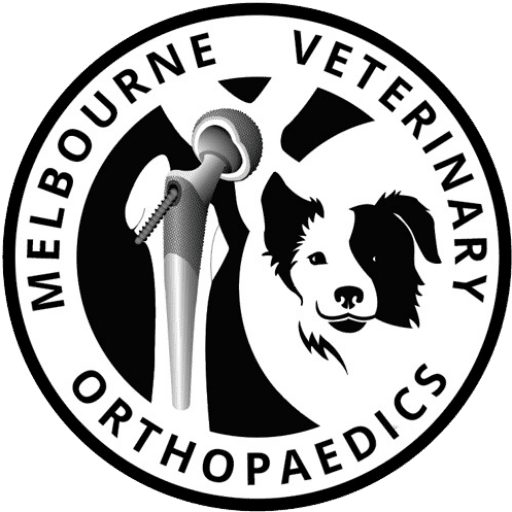Hip replacement
Journal of Veterinary Surgery 2024
Common symptoms of hip pain:
- Progressive lameness
- Bunny hopping
- Difficulty rising
- Exercise avoidance
- Swaying gait
- Reluctance to stand
- Crouched stance
- Unable to climb into car
- Muscle atrophy / wastage
- Crepitus / grinding of joint
- Hyperextended hocks (compensatory)
Indications for hip replacement
Hip replacement is typically recommended for dogs with:
- Severe hip dysplasia: A genetic condition where the hip joint excessively loose, leading to arthritis and pain. This is the most common reason to perform a hip replacemen, because (1) younger dogs can benefit from this surgery for many future years, compared to an older dog. (2) juvenile hip dysplasia will progress and only get worse.
Orthopaedic examination
Minor left hip pain in Smithfield terrier pup. A normal hip joint allows full extension without discomfort.
This juvenile Dogue de Bordeaux from interstate was referred to Dr Chris twenty years ago. You can see the disability due to loose painful hips.
There is no knee pain but severe hip pain when the joint is moved. Poor musculature on the hindlimbs results from unwillingness to run and jump.
- Advanced arthritis: Severe, chronic arthritis that causes significant pain and mobility issues. When pain management, physical therapy, and other non-surgical treatments do not provide sufficient relief.
- Hip fractures: Traumatic injuries to the hip that cannot be repaired through other means.
- Chronic hip luxation: traumatic dislocation can be treated with manipulation and a sling but if this fails, hip replacement surgery is appropriate.
- Avascular necrosis: small dogs can develop done degeneration which results in hip arthritis. This is called Legg Perthes disease.
Diagnostic Imaging
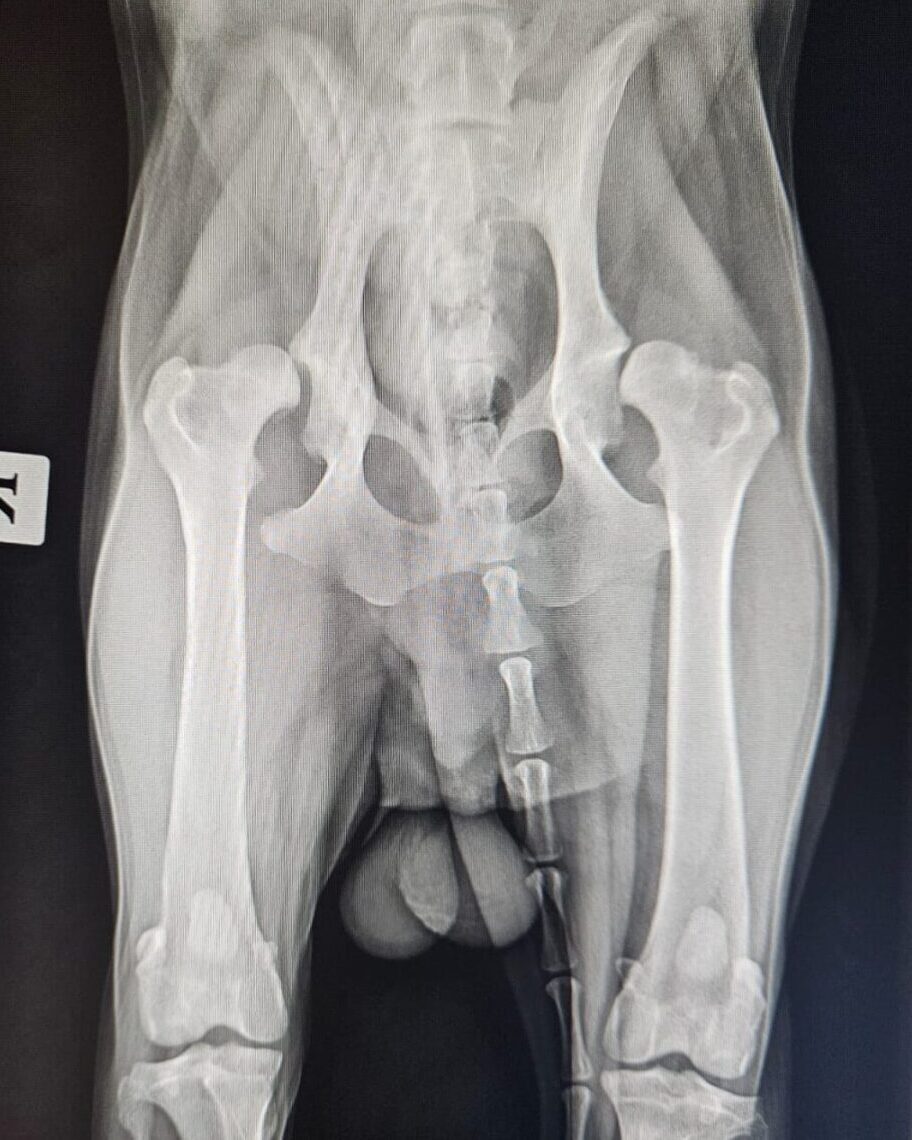
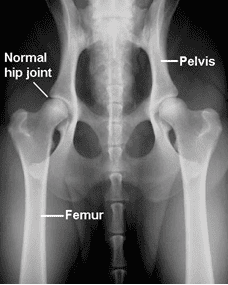
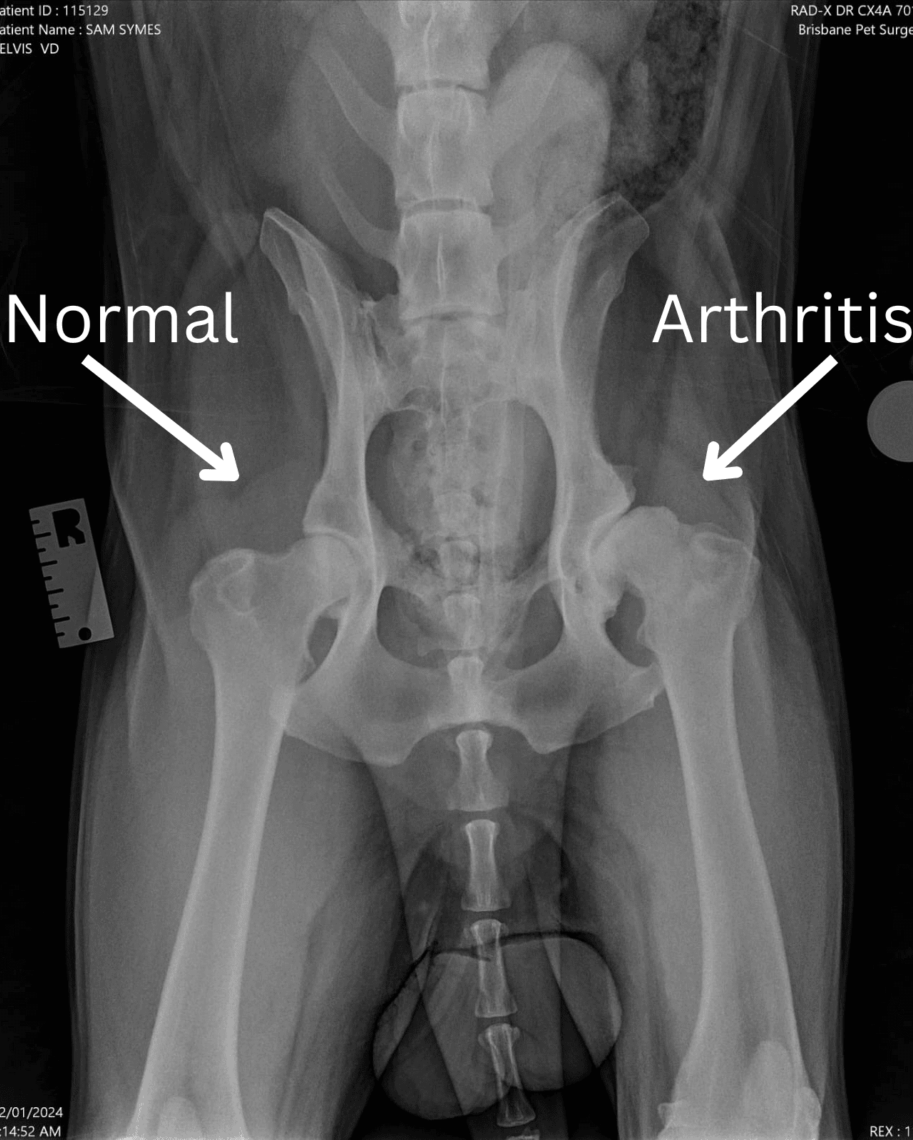
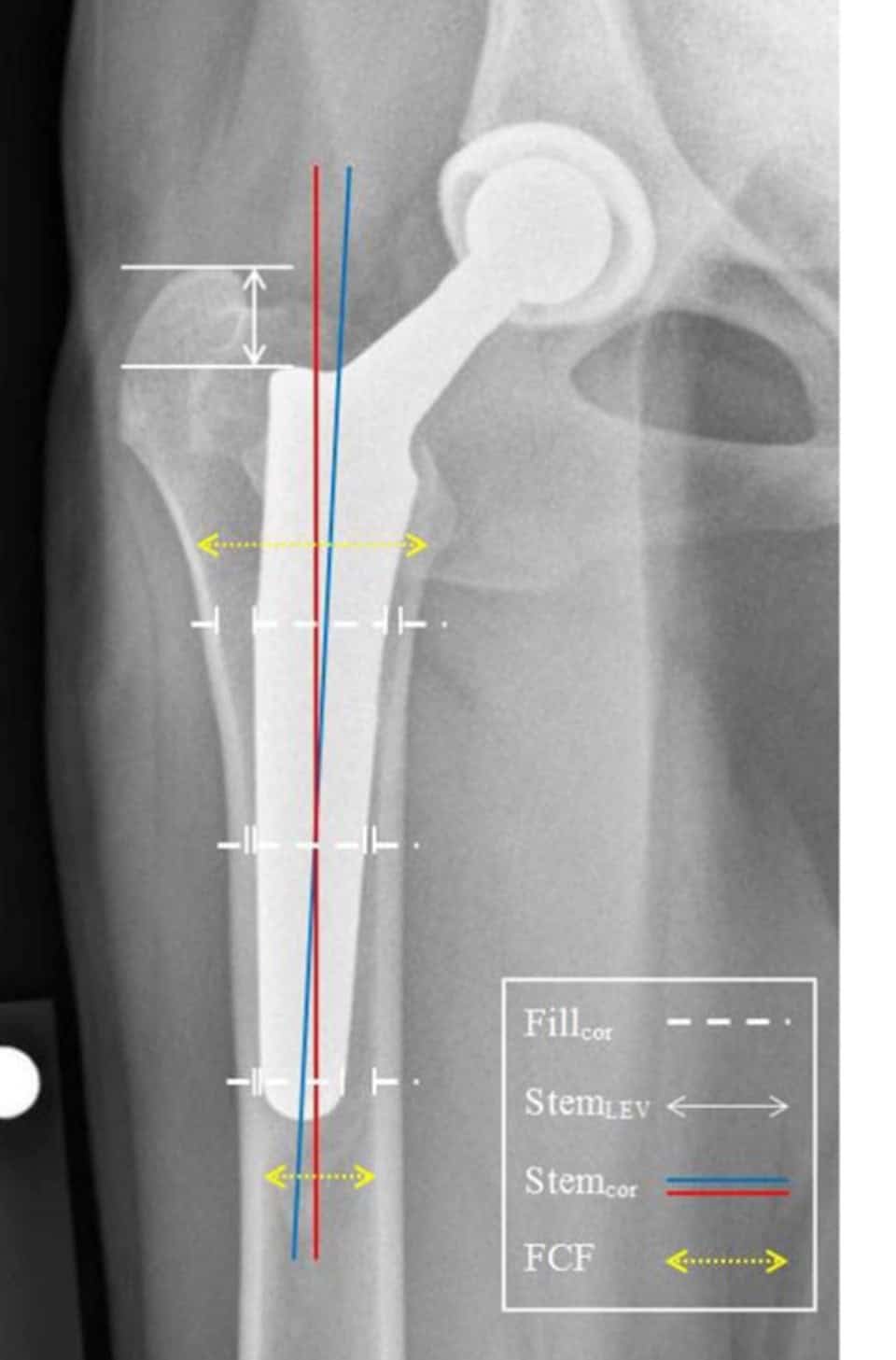
Types of hip replacement
- Cemented: This was the only available option for many years in dogs. It is referred in geriatrics and in some giant breeds but increases some risks.
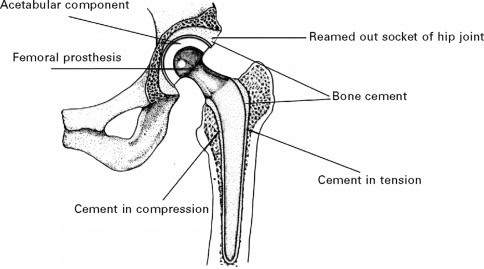
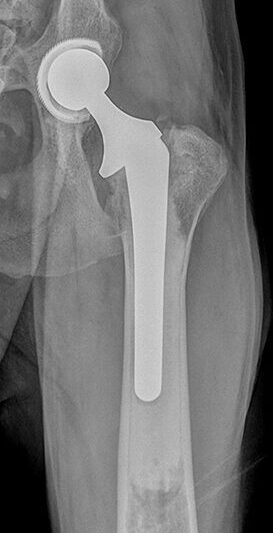
- Cementless: The majority of specialists Worldwide recommend an uncemented implant due to superior results. Surgery is faster, has a lower infection rate and the skeleton grows into and into the mesh on the outside of the titanium.
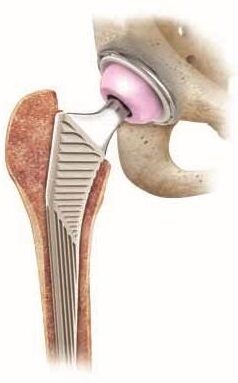
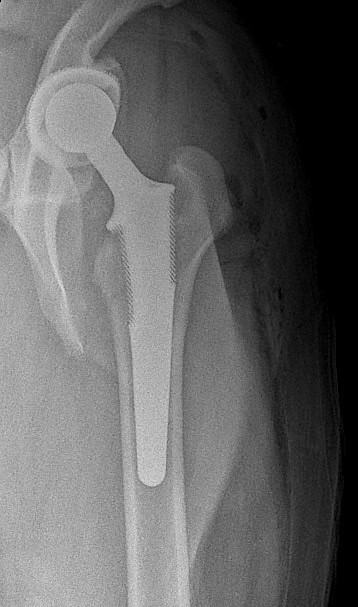
-
Micro Hip Replacement (<12kg): MVO offers hip replacements is all sizes of dogs. This chart shows extremely small implants that are available. The smallest cup is 10mm in diameter !
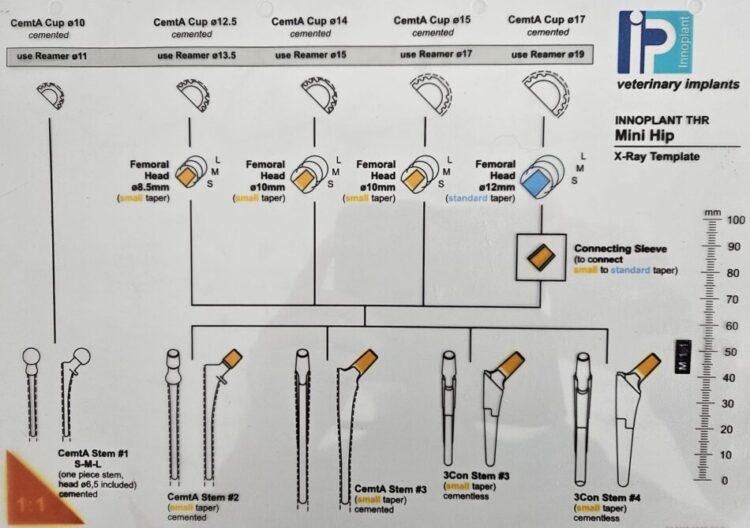
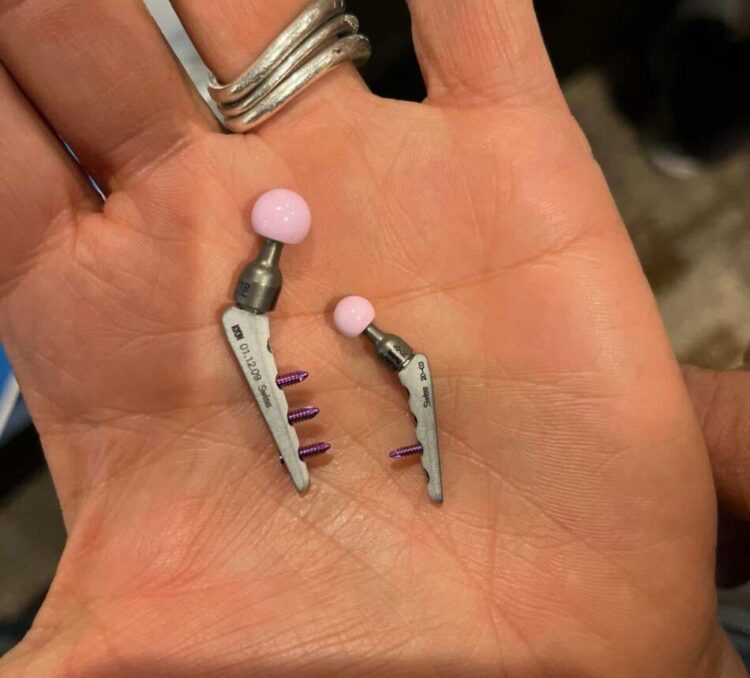
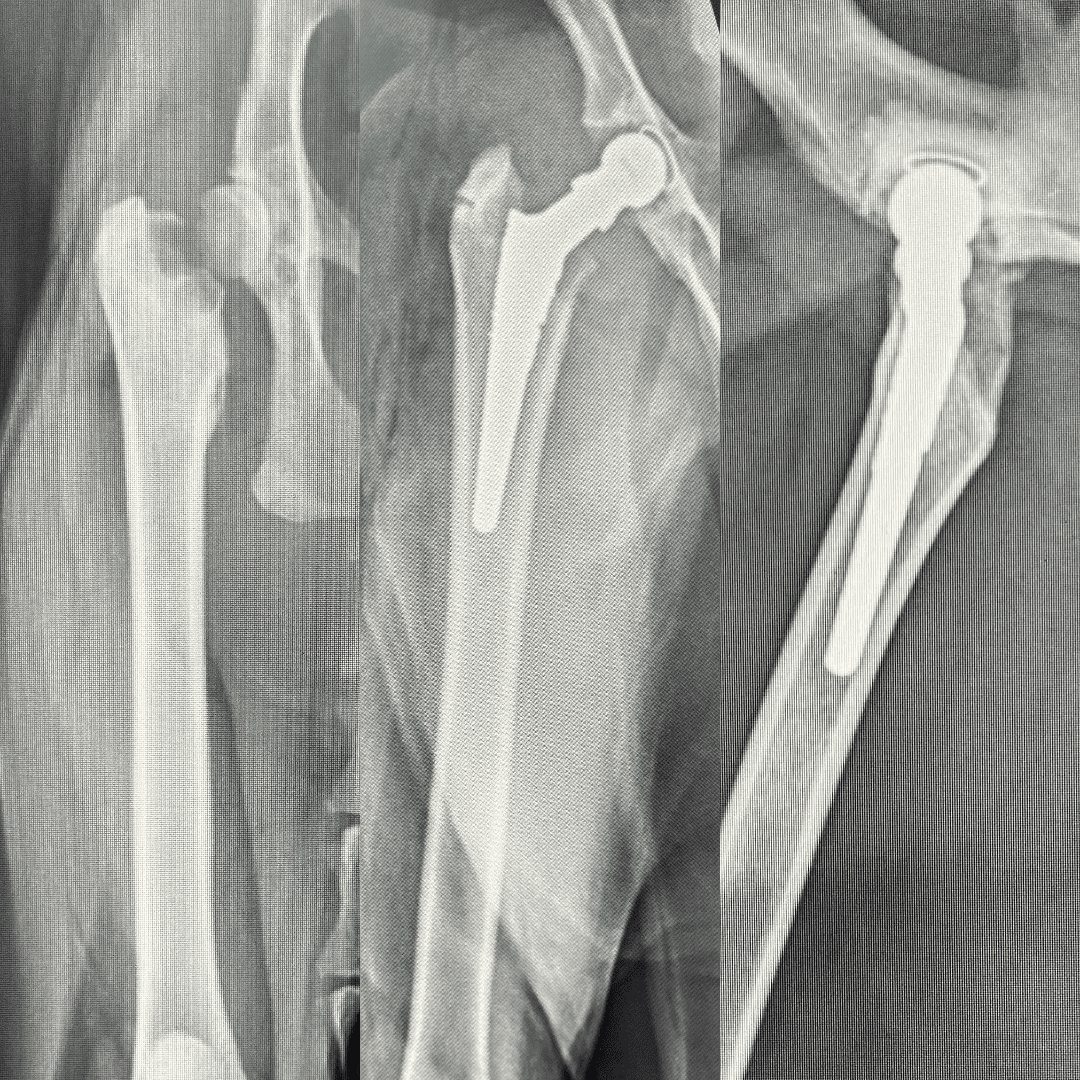
Giant breeds
The Boerboel is a South African breed of large dog of mastiff type, used as a family guard dog. It is large, with a short coat, strong bone structure and well-developed muscles. This 5yo hip replacement patient was done in 2006 and was 80kg.
Implants
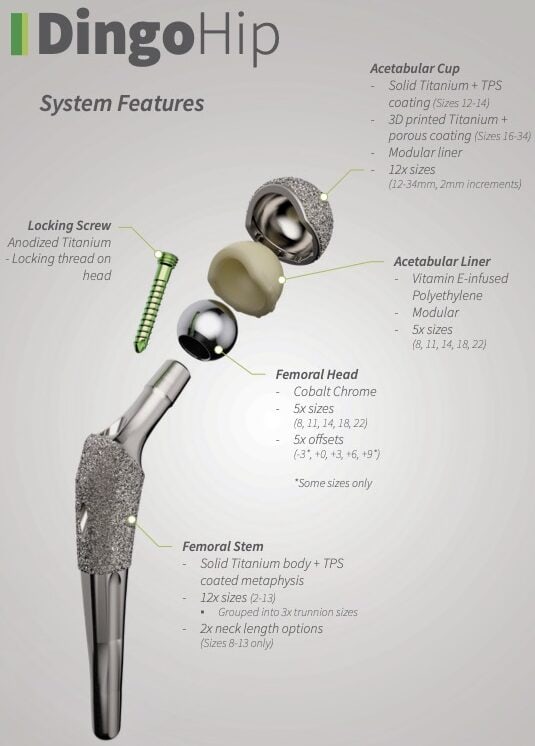
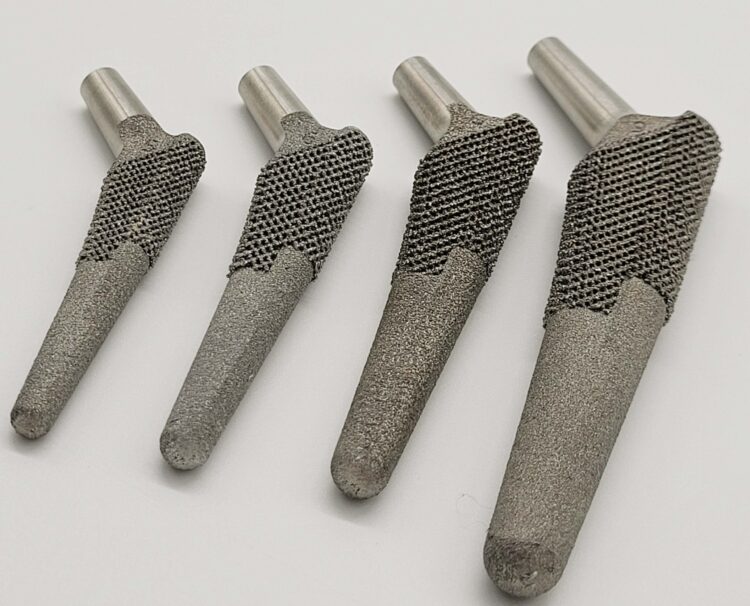
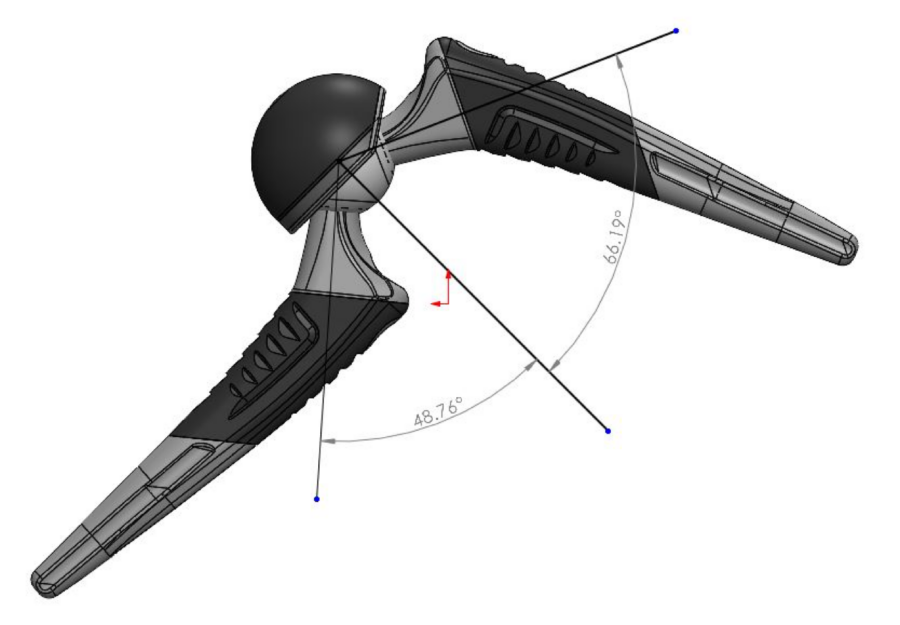
The hip replacement procedure
Pre-surgical preparation
- Diagnostic imaging: X-rays, CT scans, or MRIs are used to assess the condition of the hip joint.
- Pre-anesthesia screening: Blood tests and other evaluations ensure the dog is healthy enough for surgery.
Surgery
- Anesthesia: The dog is placed under general anesthesia.
- Incision: A surgical incision is made over the hip to access the joint.
- Removal of damaged joint: The surgeon removes the femoral head and the acetabulum to prepare for the implants.
- Placement of artificial components: The artificial femoral head and acetabulum are fitted and secured into place. These components are typically made from durable materials like metal and polyethylene.

- Closure: The incision is closed, and the dog is moved to recovery.
Navigation
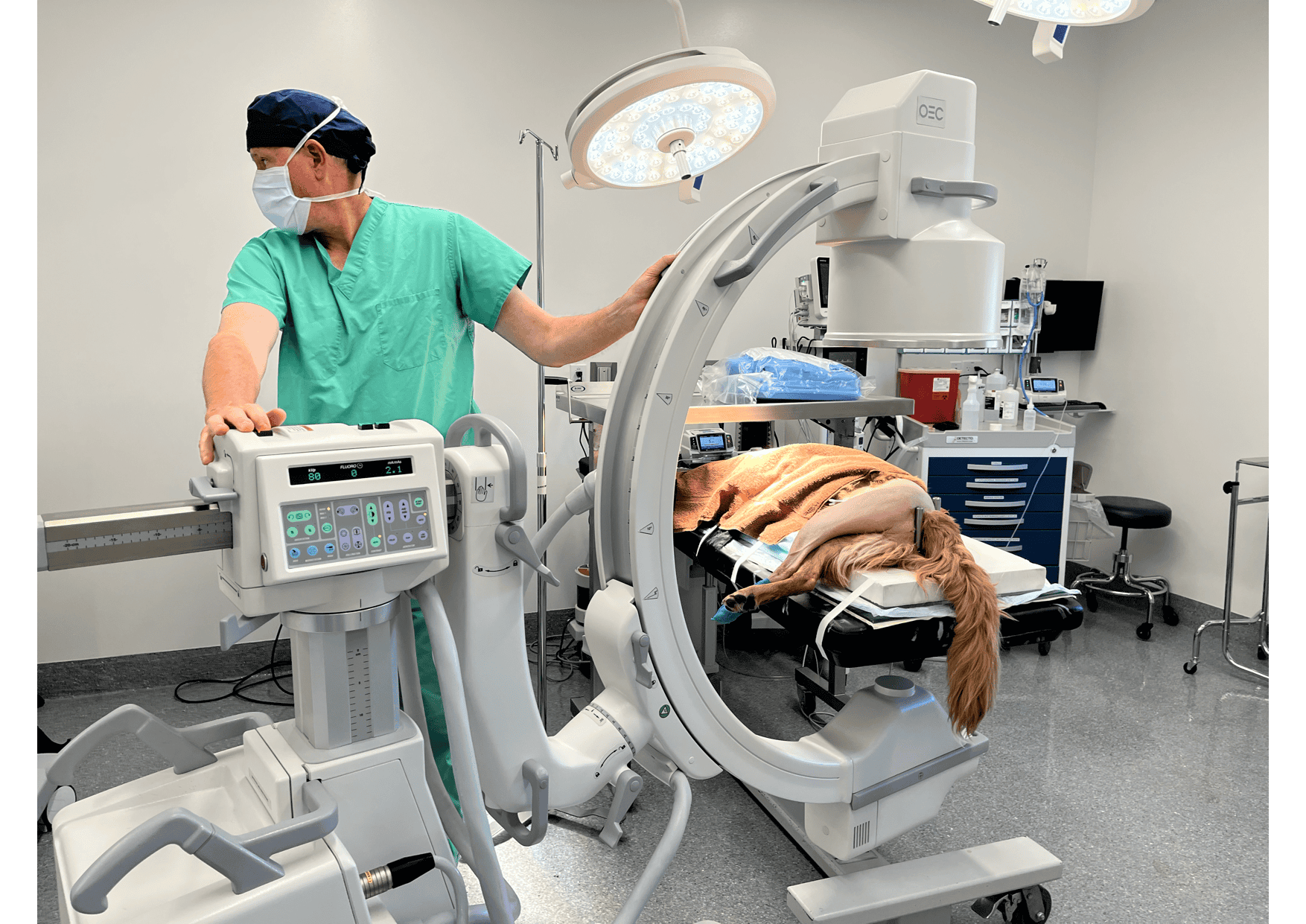
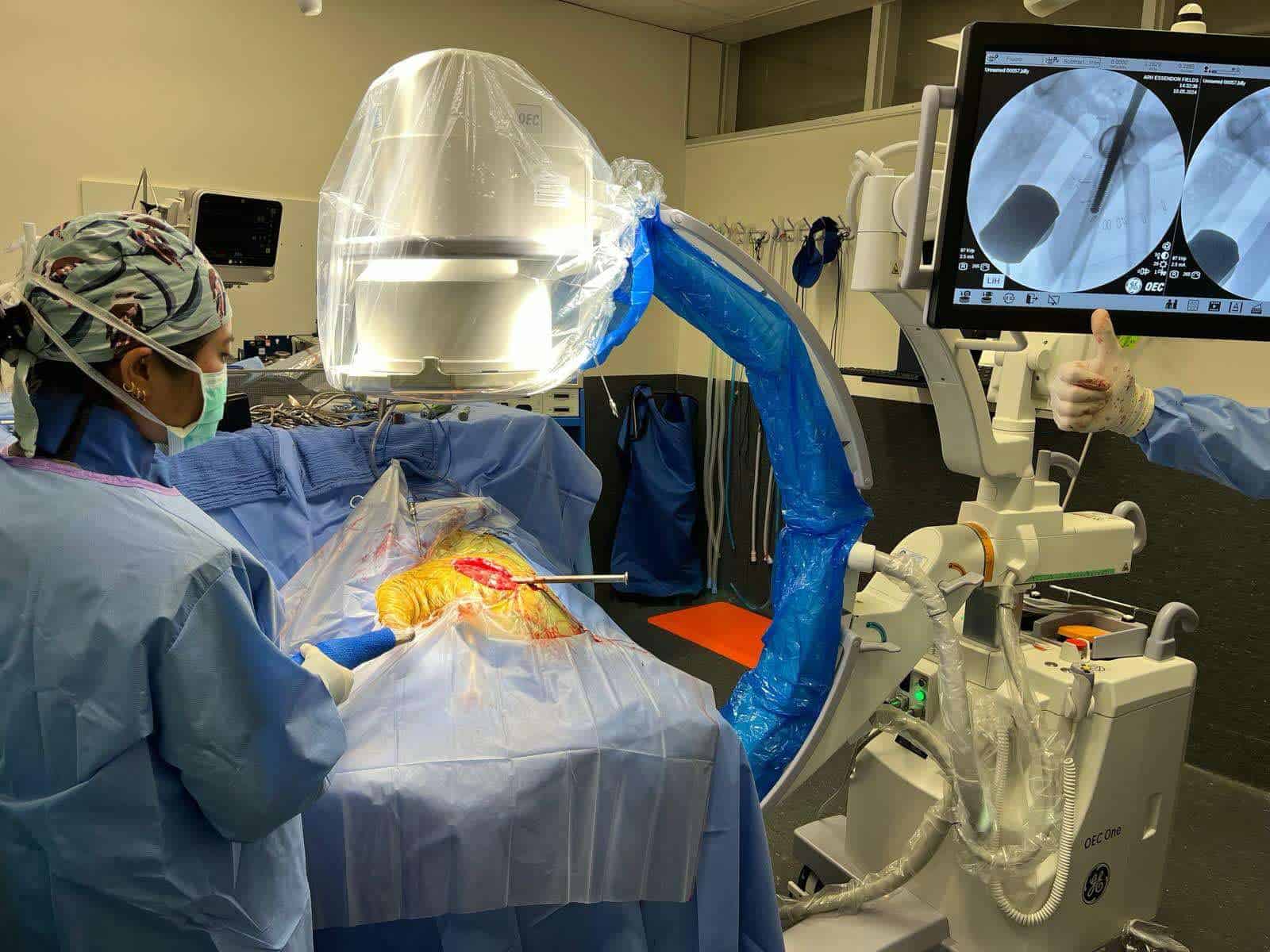
Post-surgical care
Immediate post-operative care
- Pain management: Pain relief is provided through medications.
- Restricted activity: Strict activity restriction is essential to allow proper healing, often involving crate rest and short, controlled leash walks.
Rehabilitation
- Physical therapy: Exercises to improve strength and flexibility, tailored to the dog’s recovery stage.
- Gradual return to activity: Over several weeks, activity levels are gradually increased as healing progresses.
Follow-up visits
- Regular check-ups: Frequent veterinary visits are necessary to monitor healing and ensure the implant is functioning correctly.
Benefits of hip replacement
- Pain relief: Significant reduction or complete elimination of chronic pain.
- Improved mobility: Restoration of normal joint function, allowing the dog to walk, run, and play without discomfort.
- High success rate: The majority of dogs experience a substantial improvement in quality of life after surgery.
Recovery timeline
- First 2 weeks: Strict confinement with minimal activity.
- 6-8 weeks: Gradual increase in activity under the guidance of the veterinarian.
- 10-12 weeks: Most dogs return to a nearly normal activity level, with full recovery typically occurring within 2-3 months.
What about both hips?
Most dogs suffering from hip dysplasia are bilaterally affected which means the left and right joints are a source of pain. Many pet owners think about and ask if both sides need to be done.
The answer is no. We typically choose the worst hip to replace. This gives the dog a pain free hindlimb and they will lean onto that side after surgery. It improves many dogs sufficiently to enjoy life and be more mobile. Only 50% of client pursue the second side.
If you decide you want both hips pain-free, we can stage the second procedure soon after the first side is done. Even as early as two weeks later. This overlaps the two recovery periods and the overall period of strict activity restriction is less.
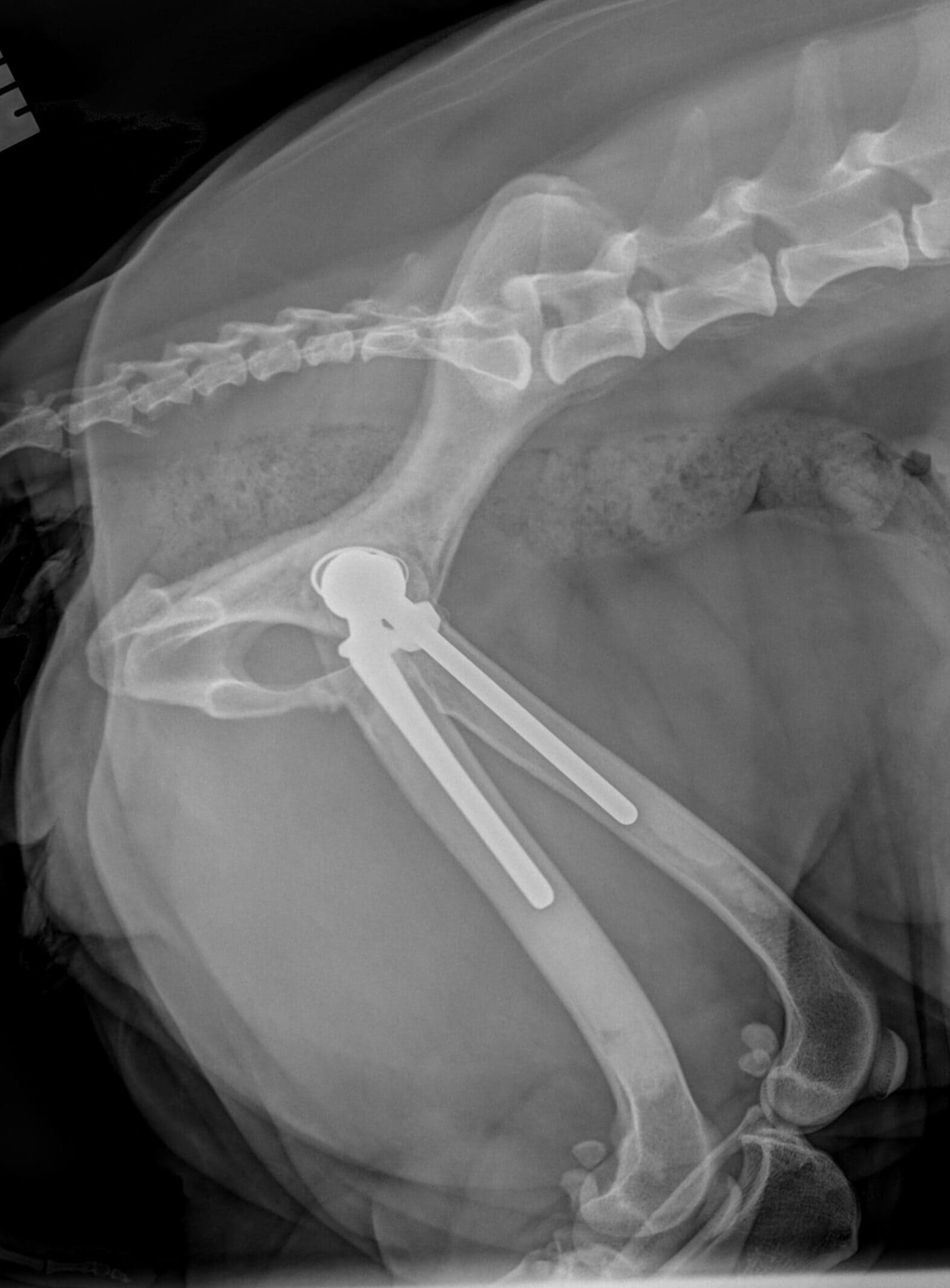
Risks and complications
- Infection: A potential risk, though it can be managed with proper care and antibiotics in most dogs. Deep infection that cannot be cleared requires removal of implants.
- Implant loosening: Rare, but possible, may require revision surgery.
- Broken leg: the presence of a metal implant inside the top of the thigh bone creates a stresss riser where bending forces are concentrated. This can contribute to a fracture below the implant.
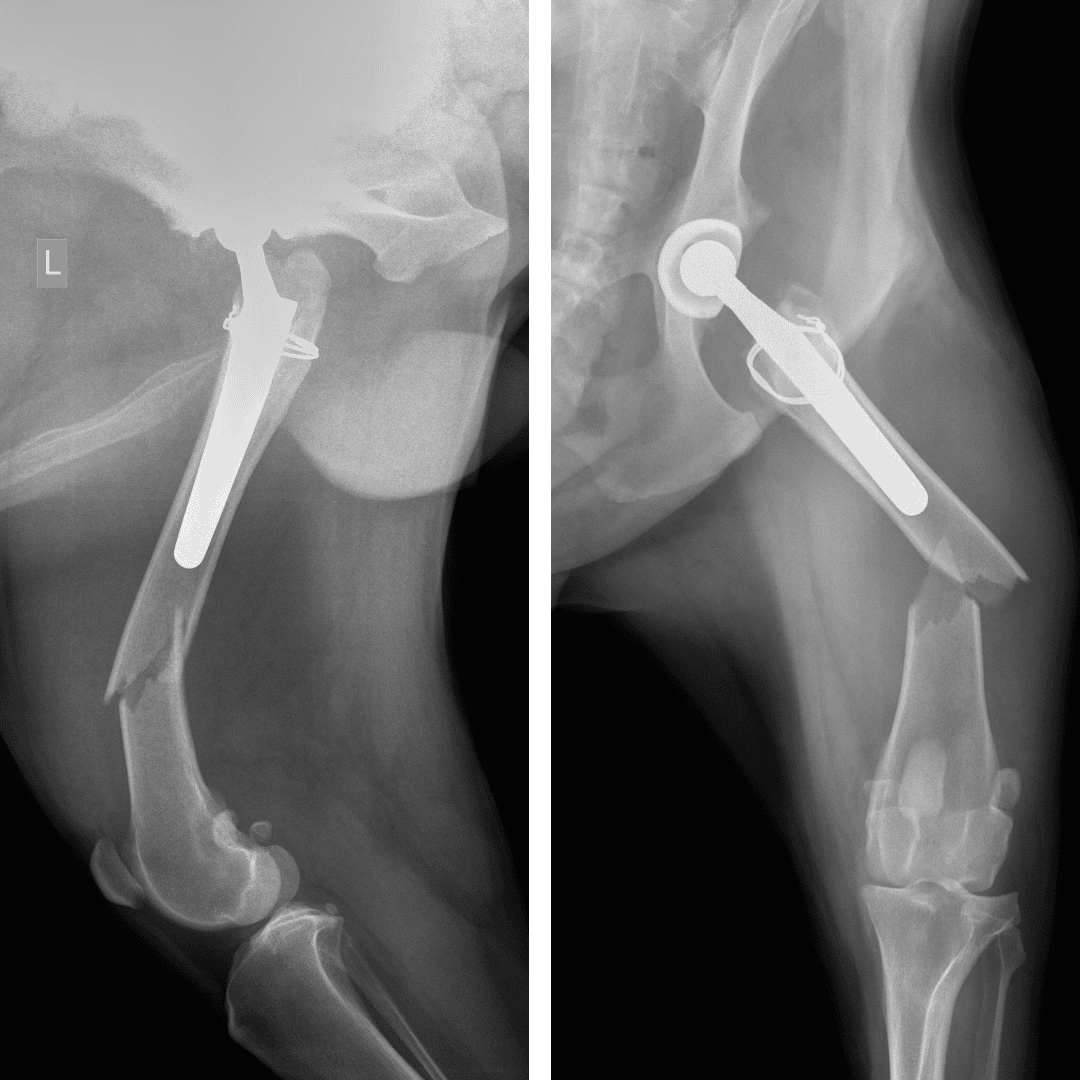
- Dislocation: The artificial joint may dislocate, particularly in the early stages of recovery.
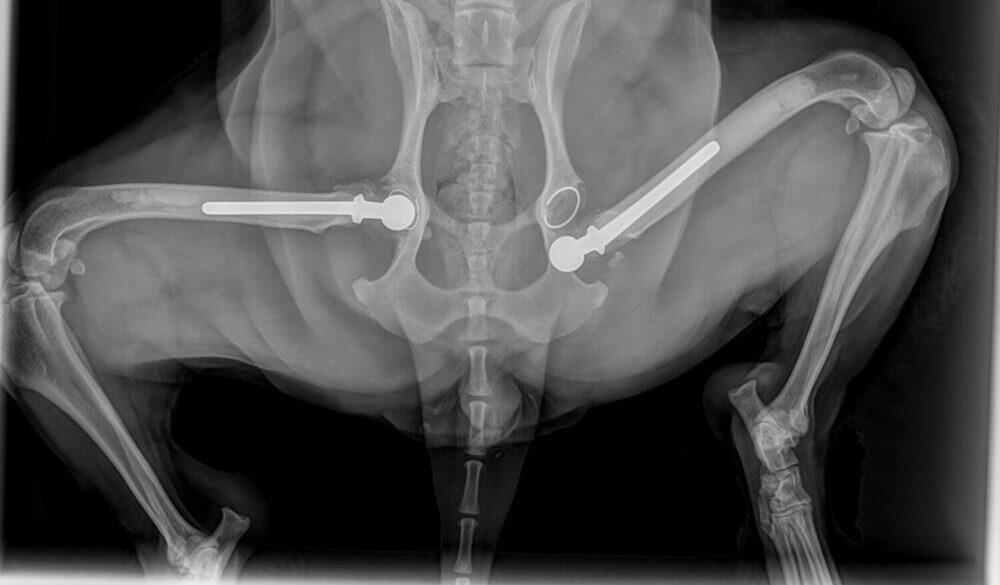
- Nerve damage: There is a small risk of nerve injury during surgery. The sciatic nerve can be stretched during surgery causing temporary dysfunction.
Cost of hip replacement
- Expense: The surgery is costly, often ranging from $10,000 to $15,000 or more, depending on the complexity of the case and the location of the surgery. MVO offers unbeatable pricing, significantly lower than traditional specialist hospitals.
Alternatives to hip replacement
- Conservative management: Pain medications, anti-inflammatory drugs, weight management, and physical therapy can help manage symptoms in less severe cases.
- Femoral head ostectomy (FHO): A surgical procedure where the femoral head is removed, creating a “false joint.” This is often recommended for smaller dogs or those for whom total hip replacement is not an option.

FHO is a salvage procedure like hip replacement but does not require implants and is cheaper. This may suit your situation but is inferior to a joint replacement as it does not restore ball-and-socket function.
There is a tendency for vets to overuse this procedure in our industry and not confidently offer hip replacement. FHO is suit-able if it is acceptable to have compromised hip joint integrity, if lack of total pain relief is acceptable, or if there are financial constraints.
One week after souble FHO
Duff and Campbell reported shortened limbs, restricted hip movement, and multiple other problems in a study of 267 FHO surgery patients. Difficulty jumping and climbing stairs was not uncommon. Muscle atrophy was reported in about 50% of the dogs and was a frequent finding by dog owners even 8 years after surgery. This atrophy can only indicate diminished limb function. Another common finding was difficulty jumping and climbing stairs. 20% of the dogs had hip pain when examined and the high incidence of pain was present during the first year after surgery. 40% of the dogs had reduced extension of the knee on the operated side. 51% of the dogs had reduced hip extension and 50% had bony and or soft tissue crepitation in the joint. There was a high incidence of pain in the first postoperative year. Patella instability was present 18% of the time and all were small breed dogs that had limb shortening. 50% of the dogs were walking “well” in 8 -10 weeks and only 75% were running in 4 – 5 months. 69% of the dogs examined had limb shortening, especially in small breeds having surgery for avascular necrosis of the femoral head. 60% of the dogs showed prominence of the greater trochanter of the femur associated with true limb shortening. Only 50% of the dogs were walking “well” after 8 – 10 weeks and 75% by 3 – 4 months. 50% of the dogs were running well after 10-12 weeks and 75% were considered to be running well by 4-5 months.
Long term results of 35 operations: Journal American Animal Hospital Association 1977
Gendreau and Cawley reported on 35 FHO operations with the average follow-up interval of 3.1 years after surgery. Only 37.1% of the dogs had “Excellent” function, which was defined as no disability and inability to tell which limb had surgery. 25.7% had “Good” function (slight gait abnormality that may occasionally be more severe), 25.7% had “Fair” function (noticeable lameness or carrying the leg in adverse weather conditions or when running), and 11.4% had “Poor” function (severe gait impediment and carrying the leg most of the time). The conclusion was that the FHO does not always return function to the operated limb. The outcome appears to be less favourable in larger dogs, but some small dogs and a cat had poor or fair results. Young dogs did not have better results than older dogs.
Femoral Head and Neck Ostectomy in Textbook of Current Techniques in Small Animal Surgery
Vasseur states in his publication that in mature dogs with severe degenerative joint disease involving the hip joints, total hip replacement restores hip function more consistently, and much more rapidly, than FHO. He recommends a vigorous rehabilitation program and maintenance of normal body weight to help restore function. Complications include shortening of the operated limb, with prominence of the greater trochanter, decreased range of motion in the pseudoarthrosis as compared to the normal hip, muscle atrophy, and impaired function. Occasional lameness is not unusual in larger dogs, and they may have difficulty jumping and climbing stairs. In addition, hunting dogs or dogs expected to perform other challenging physical tasks should not anticipate a complete return to normal function. Vasseur also states that it may take as long as 6 to 12 months for the animal to achieve an optimal result after FHO, with only fair return of function.
Grisneaux et.al. obtained objective data using force plate computerized gait analysis on limb function 3, 15, and 120 days after FHO with (for 21 days) and without the use of post-operative anti-inflammatory medication. The results show that operated dogs had significantly lower peak vertical, peak propulsive, and impulse propulsive forces on the limb and lower angles of hip joint abduction and extension than did normal dogs. Most of the limbs treated by FHO were unable to regain normal function and muscle mass after surgery. Body weight did not appear to be associated with the outcome of the FHO. The extent of muscle atrophy at the time of surgery correlated with prolonged recovery time. Dogs with the lesser trochanter preserved functioned better than those where it was partially or completely removed. Although all owners subjectively expressed complete satisfaction with results of surgery at the end of the study, operated dogs still had objec-tively significantly lower peak vertical, peak propulsive, and impulse propulsive forces and lower angles of hip joint abduction and extension than did control dogs at day 120. Owners noticed worsening of the lameness following cessation of anti-inflammatory medication. A conclusion states that active physical therapy may be a life-long necessity of dogs undergoing FHO.
Prognosis
The prognosis for dogs undergoing hip replacement surgery is generally very positive, with most dogs returning to a high level of activity and comfort. The surgery is considered one of the most effective treatments for severe hip dysplasia and arthritis, offering a long-term solution for chronic pain and mobility issues.
If your dog is suffering from hip dysplasia or severe arthritis and conservative treatments are no longer effective, consulting with a veterinary orthopedic surgeon about hip replacement surgery can provide a path to improved quality of life.
